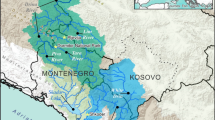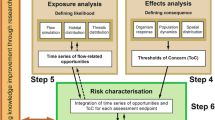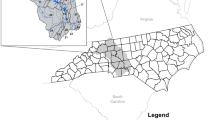Abstract
Managers can improve conservation of lotic systems over large geographies if they have tools to assess total watershed conditions for individual stream segments and can identify segments where conservation practices are most likely to be successful (i.e., primary management capacity). The goal of this research was to develop a suite of threat indices to help agriculture resource management agencies select and prioritize watersheds across Missouri River basin in which to implement agriculture conservation practices. We quantified watershed percentages or densities of 17 threat metrics that represent major sources of ecological stress to stream communities into five threat indices: agriculture, urban, point-source pollution, infrastructure, and all non-agriculture threats. We identified stream segments where agriculture management agencies had primary management capacity. Agriculture watershed condition differed by ecoregion and considerable local variation was observed among stream segments in ecoregions of high agriculture threats. Stream segments with high non-agriculture threats were most concentrated near urban areas, but showed high local variability. 60 % of stream segments in the basin were classified as under U.S. Department of Agriculture’s Natural Resources Conservation Service (NRCS) primary management capacity and most segments were in regions of high agricultural threats. NRCS primary management capacity was locally variable which highlights the importance of assessing total watershed condition for multiple threats. Our threat indices can be used by agriculture resource management agencies to prioritize conservation actions and investments based on: (a) relative severity of all threats, (b) relative severity of agricultural threats, and (c) and degree of primary management capacity.






Similar content being viewed by others
References
Annis GM, Sowa SP, Diamond DD, Combes MD, Doisy KE, Garringer AJ, Hanberry P (2009) Developing synoptic human threat indices for assessing the ecological integrity of freshwater ecosystems in EPA region 7. Final report, Environmental Protection Agency (submitted)
Bailey RG (1983) Delineation of ecosystem regions. Environ Manag 7:365–373
Barbour MT, Gerritsen J, Snyder BD, Stribling JB (1999) Rapid bioassessment protocols for use in streams and wadeable rivers: periphyton, benthic macroinvertebrates and fish, 2nd edn. EPA 841-B-99-002, U.S. Environmental Protection Agency, Office of Water, Washington, D.C.
Berkman HE, Rabeni CF, Boyle TP (1986) Biomonitors of stream quality in agricultural areas: fish versus invertebrates. Environ Manag 10:413–419
Bouska WW, Keane T, Paukert CP (2010) The effects of road crossings on Prairie Stream habitat and function. J Freshw Ecol 25:499–506
Danz N, Niemi G, Regal R, Hollenhorst T, Johnson L, Hanowski J, Axler R, Ciborowski J, Hrabik T, Brady V, Kelly J, Morrice J, Brazner J, Howe R, Johnston C, Host G (2007) Integrated measures of anthropogenic stress in the U.S. Great Lakes Basin. Environ Manag 39:631–647
Diana M, Allan JD, Infante D (2006) The influence of physical habitat and land use on stream fish assemblages in southeastern Michigan. In: Hughes RM, Wang L, Seelbach PW (eds) Landscape influences on stream habitats and biological assemblages. American Fisheries Society, Symposium 48, Bethesda, MD, 359–374
Esselman PC, Infante DM, Wang L, Wu D, Cooper A, Taylor WW (2010) An initial assessment of relative landscape disturbance levels for river fish habitats of the conterminous United States. National Fish Habitat Action Plan
Frimpong EA, Angermeier PL (2010) Comparative utility of selected frameworks for regionalizing fish-based bioassessments across the United States. Trans Am Fish Soc 139:1872–1895
Frothingham KM, Rhoads BL, Herricks EE (2001) Stream geomorphology and fish community structure in channelized and meandering reaches of an agricultural stream. In: Dorava JM, Montgomery DR, Palcsak BB, Fitzpatrick FA (eds) Geomorphic processes and riverine habitat. American Geophysical Union, Washington D.C., pp 105–117
Galat DL, Berry CR, Peters EJ, White RG (2005) Missouri River Basin. In: Benke AC, Cushing CE (eds) Rivers of North America. Elsevier, Oxford, pp 427–480
Groves CR, Jensen DB, Valutis LL, Redford KH, Shaffer ML, Scott JM, Baumgartner JV, Higgins JV, Beck MW, Anderson MG (2002) Planning for biodiversity conservation: putting conservation science into practice. BioScience 52:499–512
Hatt BE, Fletcher TD, Walsh CJ, Taylor SL (2004) The influence of urban density and drainage infrastructure on the concentrations and loads of pollutants in small streams. Environ Manag 34:112–124
Homer C, Huang C, Yang L, Wylie B, Coan M (2004) Development of a 2001 national landcover database for the United States. Photogram Eng Remote Sens 70:829–840
Karr JR (1981) Assessment of biotic integrity using fish communities. Fisheries 6:21–27
Karr JR, Fausch KD, Angermeier PL, Yant PR, Schlosser IJ (1986) Assessing biological integrity in running waters: a method and its rationale. Special Publication 5, Illinois Natural History Survey, Urbana, IL
Kondolf GM (1997) Hungry water: effects of dams and gravel mining on river channels. Environ Manag 21:533–551
Leonard PM, Orth DJ (1986) Application and testing of an index of biotic integrity in small, coolwater streams. Trans Am Fish Soc 115:401–414
Ligon FK, Dietrich WE, Trush WJ (1995) Downstream ecological effects of dams. BioScience 45:183–192
Mattson KM, Angermeier PL (2007) Integrating human impacts and ecological integrity into a risk-based protocol for conservation planning. Environ Manag 39(1):125–138
Palmer MA, Bernhardt ES, Allan JD, Lake PS, Alexander G, Brooks S, Carr J, Clayton S, Dahm CN, Shah JF, Galat DL, Loss SG, Goodwin P, Hart DD, Hassett B, Jenkinson R, Kondolf GM, Lave R, Meyer JL, O’Donnell TK, Pagano L, Sudduth E (2005) Standards for ecologically successful river restoration. J Appl Ecol 42:208–217
Paukert CP, Pitts KL, Whittier JB, Olden JD (2011) Development and assessment of a landscape-scale ecological threat index for the Lower Colorado River Basin. Ecol Indic 11:304–310
Poff NL (1997) Landscape filters and species traits: towards mechanistic understanding and prediction in stream ecology. J N Am Benthol Soc 16:391
Poff NL, Olden JD, Merritt DM, Pepin DM (2007) Homogenization of regional river dynamics by dams and global biodiversity implications. Proc Nat Acad Sci 104:5732–5737
Revenga C, Murray S, Abramovitz J, Hammond A (1998) Watersheds of the world: ecological value and vulnerability. Worldwatch Institute, Washington, D.C.
Rhoads BL, Schwartz JS, Porter S (2003) Stream geomorphology, bank vegetation, and three-dimensional habitat hydraulics for fish in midwestern agricultural streams. Water Resour Res 39:21–23
Roy AH, Freeman MC, Freeman BJ, Wenger SJ, Ensign WE, Meyer JL (2005) Investigating hydrologic alteration as a mechanism of fish assemblage shifts in urbanizing streams. J N Am Benthol Soc 24:656–678
Snyder CD, Young JA, Villella R, Lemarié DP (2003) Influences of upland and riparian land use patterns on stream biotic integrity. Landscape Ecol 18(7):647–664
Sowa SP, Annis G, Morey ME, Diamond DD (2007) A GAP analysis and comprehensive conservation strategy for riverine ecosystems of Missouri. Ecol Monogr 77:301–334
Stoddard JL, Herlihy AT, Peck DV, Hughes RM, Whittier TR, Tarquinio E (2008) A process for creating multimetric indices for large-scale aquatic surveys. J N Am Benthol Soc 27:878–891
Sutherland AB, Meyer JL, Gardiner EP (2002) Effects of land cover on sediment regime and fish assemblage structure in four southern Appalachian streams. Freshw Biol 47:1791–1805
US Environmental Protection Agency OoW (2001) Protecting the Nation’s waters through effective NPDES permits: a strategic plan FY 2001 and beyond. EPA-833-R-01-001, United States Environmental Protection Agency, Office of Water, Washington, D.C.
Wang L, Lyons J, Kanehl P, Gatti R (1997) Influences of watershed land use on habitat quality and biotic integrity in Wisconsin streams. Fisheries 22:6–12
Wang L, Lyons J, Kanehl P, Bannerman R, Emmons E (2000) Watershed urbanization and changes in fish communities in southeastern Wisconsin streams. J Am Water Resour Assoc 36(5):1173–1189
Wang L, Lyons J, Kanehl P, Bannerman R (2001) Impacts of urbanization on stream habitat and fish across multiple spatial scales. Environ Manag 28(2):255–266
Waters TF (1995) Sediment in streams: sources, biological effects, and control. American Fisheries Society Monograph 7, Bethesda, MD
Wolman MG, Schick AP (1967) Effects of construction on fluvial sediment, urban and suburban areas of Maryland. Water Resour Res 3:451–464
Young KD, Thackston EL (1999) Housing density and bacterial loading in urban streams. J Environ Eng 125:1177–1180
Zorn TG, Wiley MJ (2006) Influence of landscape characteristics on local habitat and fish biomass in streams of Michigan’s lower peninsula. In: Hughes RM, Wang L, Seelbach PW (eds) Landscape influences on stream habitats and biological assemblages. American Fisheries Society, Symposium 48, Bethesda, MD, 375–393
Acknowledgments
We thank the United States Department of Agriculture’s Natural Resource Conservation Service under the Conservation Effects Assessment Project for funding this project. Michael Morey provided technical assistance and Aaron Garringer conducted much of the GIS work. Matt Combes of Missouri Department of Conservation provided fish IBI data. This manuscript was improved by helpful reviews from Charles Rabeni and two anonymous reviewers.
Author information
Authors and Affiliations
Corresponding author
Electronic supplementary material
Below is the link to the electronic supplementary material.
Rights and permissions
About this article
Cite this article
Fore, J.D., Sowa, S.P., Galat, D.L. et al. Riverine Threat Indices to Assess Watershed Condition and Identify Primary Management Capacity of Agriculture Natural Resource Management Agencies. Environmental Management 53, 567–582 (2014). https://doi.org/10.1007/s00267-013-0222-6
Received:
Accepted:
Published:
Issue Date:
DOI: https://doi.org/10.1007/s00267-013-0222-6




